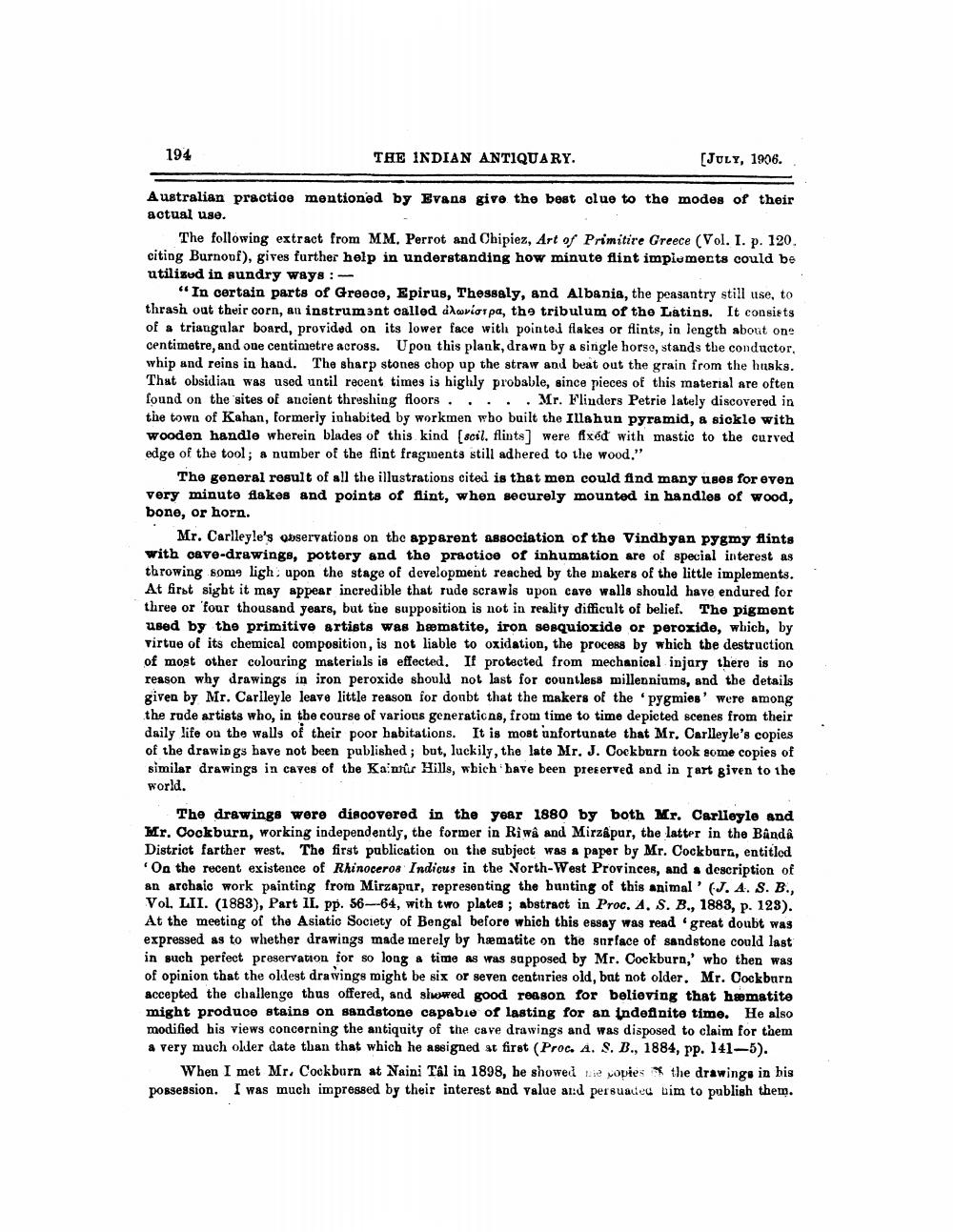________________
194
THE INDIAN ANTIQUARY.
[JULY, 1906.
Australian practice mentioned by Evans give the best clue to the modes of their actual use.
The following extract from MM. Perrot and Chipiez, Art of Primitire Greece (Vol. I. p. 120. citing Burnonf), gives further help in understanding how minute flint implements could be utilisud in sundry ways:
“In certain parts of Greece, Epirus, Thessaly, and Albania, the peasantry still use, to thrash out their corn, an instrumant called duriorpa, the tribulum of the Latins. It consists of a triangalar board, provided on its lower face with pointed flakes or flints, in length about one centimetre, and one centimetre across. Upon this plank, drawn by a single horso, stands the conductor, whip and reins in hand. The sharp stones chop up the straw and beat out the grain from the husks. That obsidian was used until recent times is highly probable, since pieces of this material are often found on the sites of ancient threshing floors.... Mr. Flinders Petrie lately discovered in the town of Kahan, formerly inhabited by workmen who built the Illahun pyramid, & sickle with wooden handle wherein blades of this kind scil. flints] were fixed with mastic to the curved edge of the tool; a number of the flint fragments still adhered to the wood."
The general result of all the illustrations cited is that men could find many uses for even very minute Aakes and points of flint, when securely mounted in handles of wood, bone, or horn.
Mr. Carlleyle's observations on the apparent association of the Vindhyan pygmy flints with cave-drawings, pottery and the practice of inhumation are of special interest as throwing some ligh: upon the stage of development reached by the makers of the little implements. At first sight it may appear incredible that rude scrawis upon cave walls should have endured for three or 'four thousand years, but the supposition is not in reality difficult of belief. The pigment used by the primitive artists was hematite, iron sesquioxide or peroxide, which, by Virtue of its chemical composition, is not liable to oxidation, the process by which the destruction of most other colouring materials is effected. If protected from mechanical injary there is no reason why drawings in iron peroxide should not last for countless millenniums, and the details given by Mr. Carlleyle leave little reason for donbt that the makers of the pygmies' were among the rude artists who, in the course of various generations, from time to time depicted scenes from their daily life on the walls of their poor habitations. It is most unfortunate that Mr. Carlleyle's copies of the drawings have not been published; but, luckily, the late Mr. J. Cockburn took some copies of similar drawings in caves of the Kann Hills, wbich bave been preserved and in part given to the world.
The drawings were discovered in the year 1880 by both Mr. Carlleyle and Mr. Cockburn, working independently, the former in Riwâ and Mirzapur, the latter in the Banda District farther west. The first publication on the subject was a paper by Mr. Cockburt, entitled 'On the recent existence of Rhinoceros Indicus in the North-West Provinces, and a description of an archaic work painting from Mirzapur, representing the hunting of this animal' (J. A. S. B., VOL. LII. (1883), Part II. pp. 56-64, with two plates ; abstract in Proc. A. S. B., 1883, p. 123). At the meeting of the Asiatic Society of Bengal before which this essay was read 'great doubt was expressed as to whether drawings made merely by hæmatite on the surface of sandstone could last in such perfect preservation for so long a time as was supposed by Mr. Cockburn,' who then was of opinion that the oldest drawings might be six or seven centnries old, but not older. Mr. Cockburn accepted the challenge thus offered, and showed good reason for believing that hæmatite might produce stains on sandstone capable of lasting for an indefinite time. He also modified his views concerning the antiquity of the cave drawings and was disposed to claim for them a very much older date than that which he assigned at first (Proc. A. S. B., 1884, pp. 141-5).
When I met Mr. Cockburn at Naini Tâl in 1898, be showed the popies the drawings in bis possession. I was much impressed by their interest and value and persuaded bim to publish them.




